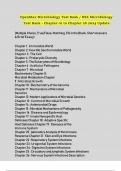OpenStax Microbiology Test Bank / OSX Microbiology
Test Bank - Chapter 01 to Chapter 26 2024 Update
(Multiple Choice, True/False, Matching, Fill in the Blank, Short Answers
& Brief Essay)
Chapter 1 : An Invisible World
Chapter 2 : How We See the Invisible World
Chapter 3 : The Cell
Chapter 4 : Prokaryotic Diversity
Chapter 5 : The Eukaryotes of Microbiology
Chapter 6 : Acellular Pathogens
Chapter 7 : Microbial
Biochemistry Chapter 8 :
Microbial Metabolism Chapter
9 : Microbial Growth
Chapter 10 : Biochemistry of the Genome
Chapter 11 : Mechanisms of Microbial
Genetics
Chapter 12 : Modern Applications of Microbial Genetics
Chapter 13 : Control of Microbial Growth
Chapter 14 : Antimicrobial Drugs
Chapter 15 : Microbial Mechanisms of Pathogenicity
Chapter 16 : Disease and Epidemiology
Chapter 17 : Innate Nonspecific Host
Defenses Chapter 18 : Adaptive Specific
Host Defenses Chapter 19 : Diseases of the
Immune System
Chapter 20 : Įaboratory Analysis of the Immune
Response Chapter 21 : Skin and Eye Infections
Chapter 22 : Respiratory System Infections
Chapter 23 : Urogenital System Infections
Chapter 24 : Digestive System Infections
Chapter 25 : Circulatory and Įymphatic System Infections
Chapter 26 : Nervous System Infections Description
,OpenStax Microbiology Test Bank
Chapter 1: An Invisible World
Chapter 1: An Invisible World
* (correct answer) =
Correct answer
Multiple Choice
1. Which of the following is true of the microbial world?
A. All microbes are harmful.
B. Humans could survive without microbes.
C. Many microbes are helpful.* (correct answer)
D. Most microbes are pathogenic.
Difficulty: Easy
ASM Standard: 23, 24
2. Which of the following is when humans first suspected the existence of microbes?
A. during the Industrial Revolution
B. in prehistoric times* (correct answer)
C. in the last century
D. within the last 500 years
Difficulty: Easy
ASM Standard: 23
3. Which individual first observed unicellular organisms, which he called “animalcules,” using
a microscope he developed?
A. Robert Koch
B. Louis Pasteur
C. Thucydides
D. Antonie van Leeuwenhoek* (correct answer)
Difficulty: Easy
ASM Standard: 6
4. To reduce the risk of open flame from Bunsen burners, microbiologists are increasingly using
which of the following devices for easy, rapid benchtop sterilization of small pieces of
equipment?
A. autoclaves
B. ethylene oxide
C. incubators
D. microincinerators* (correct answer)
Difficulty: Easy
ASM Standard: 36
Page 1 of 17
,OpenStax Microbiology Test Bank
Chapter 1: An Invisible World
5. Which kingdom was the only one found in Empire Prokaryota?
A. Animalia
B. Fungi
C. Monera* (correct answer)
D. Protista
Difficulty: Easy
ASM Standard: N/A
6. The Swedish botanist known for having developed an important biological classification
system is which of the following people?
A. Ernst Haeckel
B. Carolus Linnaeus* (correct answer)
C. Louis Pasteur
D. Robert Whittaker
Difficulty: Easy
ASM Standard: N/A
7. Which are the three currently accepted domains?
A. Archaea, Bacteria, and Eukarya* (correct answer)
B. Archaea, Prokaryota, and Eukaryota
C. Bacteria, Fungi, and Protista
D. Bacteria, Prokaryota, and Eukarya
Difficulty: Easy
ASM Standard: N/A
8. Which two taxonomic units are typically used to identify an organism when using binomial
nomenclature?
A. domain and kingdom
B. genus and family
C. genus and species* (correct answer)
D. phylum and class
Difficulty: Easy
ASM Standard: N/A
9. Which of the following is not true about the process of fermentation?
A. It can help preserve foods, preventing spoilage.
B. It converts sugars to organic acids, alcohols, and/or gases such as carbon dioxide.
C. It is carried out exclusively by unicellular eukaryotes such as yeast.* (correct answer)
D. It is used to make foods such as cheese and bread.
Difficulty: Moderate
ASM Standard: 11, 23, 26
Page 2 of 17
, OpenStax Microbiology Test Bank
Chapter 1: An Invisible World
10. For which of the following is Thucydides known?
A. developing an effective sewer system in ancient Greece, helping to reduce levels of
disease in cities
B. observing microbes, using a microscope, for the first time, even distinguishing between
bacteria and fungi
C. proposing that disease was caused by microorganisms
D. realizing that people who had been infected by the Athenian plague had immunity to
reinfection* (correct answer)
Difficulty: Moderate
ASM Standard: 23, 31
11. The Romans may have reduced their risk of waterborne infectious diseases by using which of
the following?
A. a variety of pharmaceutical products
B. aqueducts and a sewer system* (correct answer)
C. prophylactic antibiotics
D. quarantine of people with leprosy
Difficulty: Moderate
ASM Standard: 23
12. Ernst Haeckel proposed a classification system consisting of which of the following
subgroups?
A. five kingdoms
B. four kingdoms* (correct answer)
C. two domains and three kingdoms
D. two domains and five kingdoms
Difficulty: Moderate
ASM Standard: N/A
13. Viruses not included in phylogenetic trees for which of the following reasons?
A. It is too difficult to observe their characteristics.
B. They are acellular and nonliving.* (correct answer)
C. They do not have any genes, which prevents genetic analysis.
D. They lack a nucleus.
Difficulty: Moderate
ASM Standard: 5
14. Which is the best description of the primary purpose of a phylogeny?
A. Phylogenies show all the alterative names for each species.
B. Phylogenies show all the common names for each species.
C. Phylogenies show evolutionary relatedness between organisms.* (correct answer)
Page 3 of 17




